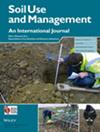结合实地测量和基于过程的建模,分析土壤耕作和作物残留物管理对温带地区作物产量和碳平衡的影响
IF 3.7
3区 农林科学
Q1 SOIL SCIENCE
引用次数: 0
摘要
作物残留物管理是气候变化背景下的一个重要问题。这些残留物可能被留在田间,重新用于土壤以提高肥力,也可能被输出用于其他用途,如通过生物甲烷化生产能源。此外,耕作方式的选择会影响残留物的吸收潜力,进而影响土壤的物理(如结构、保水性)、生物(如有机质、微生物)和化学(如通过矿化释放养分)肥力。我们结合比利时赫斯巴伊壤土地区 14 年田间试验的测量结果以及 STICS 土壤-作物模型的模拟结果,研究了土壤耕作和作物秸秆管理对作物产量、土壤特性和碳平衡的影响。对四种处理方法进行了比较,测试了作物秸秆掺入与排出、传统耕作与减少耕作的所有组合。田间观测结果与模型模拟结果的对比证明,STICS 模型足以探索这种对比管理的影响。对田间数据和土壤-作物模型输出结果的综合分析表明,作物产量受到传统耕作的积极影响,但对作物残留物的去向没有反应。减少耕作导致表土(0-30 厘米)中观察到的 SOC 含量明显分层,但也导致模拟 SOC 储量(0-26 厘米)增加。在减少耕作的情况下,这种 SOC 的增加带来了更大的保水性。此外,在两种耕作处理中,掺入残留物增加了土壤有机碳,尽管土壤异养呼吸也随之增加。最后,环境条件在碳平衡中的重要性表明,作物建模可能非常有助于探索土壤耕作和作物秸秆管理在特定农业-生态-气候环境下的影响,尤其是在面临气候变化时。本文章由计算机程序翻译,如有差异,请以英文原文为准。
Combining field measurements and process‐based modelling to analyse soil tillage and crop residues management impacts on crop production and carbon balance in temperate areas
Crop residues management is an important issue in the context of climate change. They might be kept on the field and restituted to the soil to enhance its fertility or exported for other uses such as the production of energy through biomethanization. Furthermore, the choices regarding tillage operations impact the potential to incorporate residues, which in turn affects soil physical (e.g. structure, water retention), biological (e.g. organic matter, microorganisms) and chemical (e.g. nutrient release through mineralization) fertility. We combined measurements from a 14‐year field experiment in the Hesbaye loamy region of Belgium and its simulation with the STICS soil‐crop model to investigate the impacts of soil tillage and crop residues management on crop production, soil characteristics and carbon balance. Four treatments were compared, where all combinations of the incorporation versus exportation of crop residues and conventional versus reduced tillage were tested. The comparison of field observations with model simulations proved that the STICS model is adequate to explore the impacts of such contrasted management. The combined analysis of field data and soil‐crop model outputs showed that crop production was positively influenced by conventional tillage but unresponsive to crop residues fate. Reduced tillage led to a clear stratification in observed SOC content in the topsoil (0–30 cm), but also to an increase in simulated SOC stocks (0–26 cm). This SOC gain led to greater water retention under reduced tillage. Moreover, in both tillage treatments, incorporating residues increased soil organic carbon despite the associated augmentation in soil heterotrophic respiration. Finally, the importance of environmental conditions in carbon balance suggests that crop modelling might be very useful to explore the impacts of soil tillage and crop residues management in specific agro‐pedoclimatic contexts, especially when facing climate change.
求助全文
通过发布文献求助,成功后即可免费获取论文全文。
去求助
来源期刊

Soil Use and Management
农林科学-土壤科学
CiteScore
7.70
自引率
13.20%
发文量
78
审稿时长
3 months
期刊介绍:
Soil Use and Management publishes in soil science, earth and environmental science, agricultural science, and engineering fields. The submitted papers should consider the underlying mechanisms governing the natural and anthropogenic processes which affect soil systems, and should inform policy makers and/or practitioners on the sustainable use and management of soil resources. Interdisciplinary studies, e.g. linking soil with climate change, biodiversity, global health, and the UN’s sustainable development goals, with strong novelty, wide implications, and unexpected outcomes are welcomed.
 求助内容:
求助内容: 应助结果提醒方式:
应助结果提醒方式:


